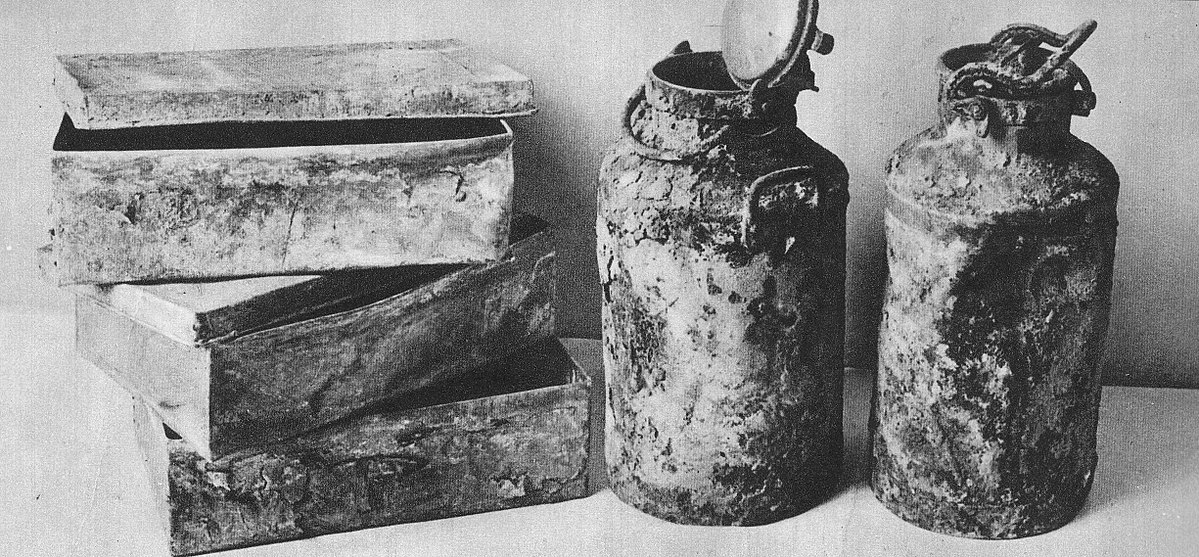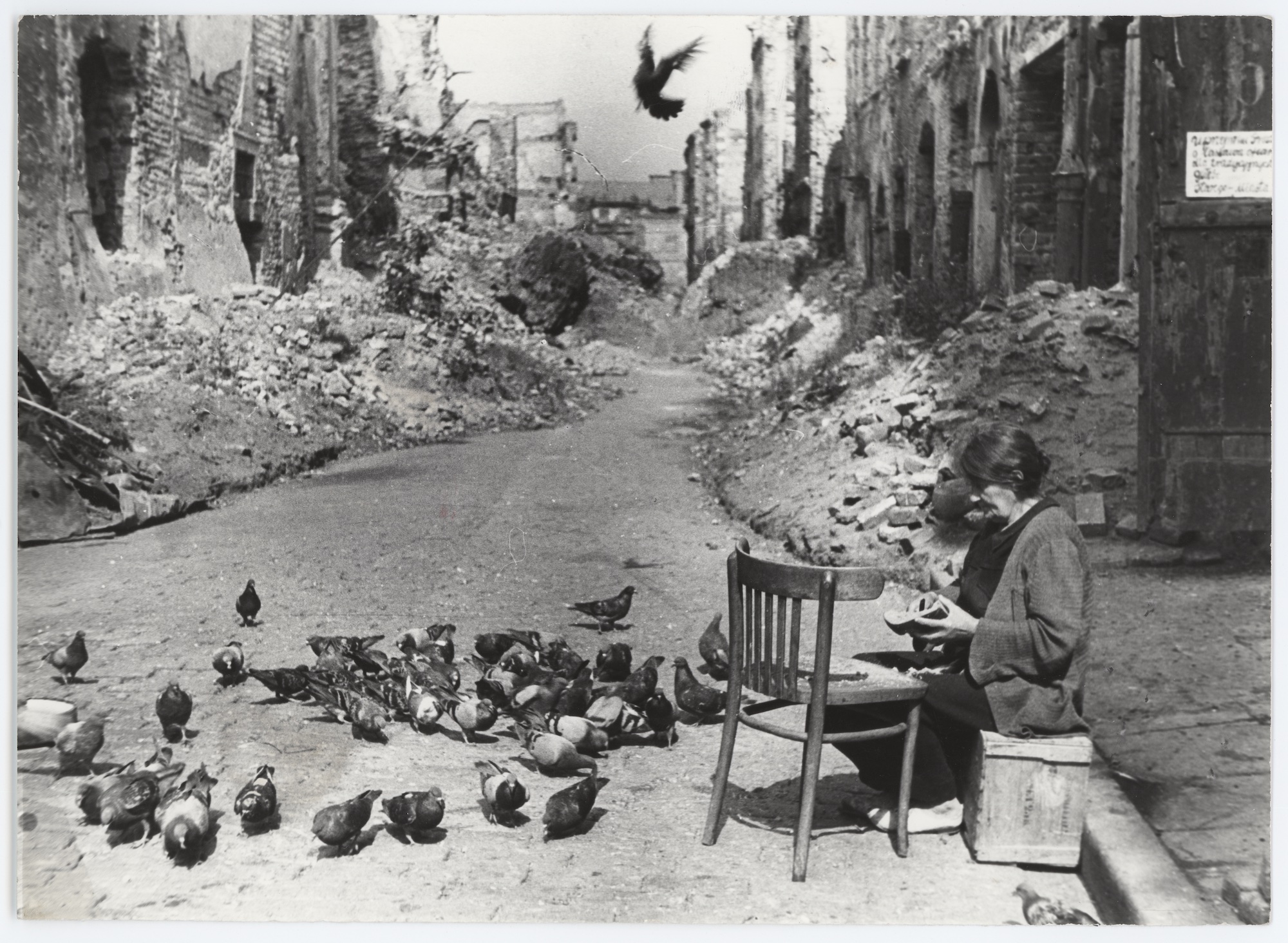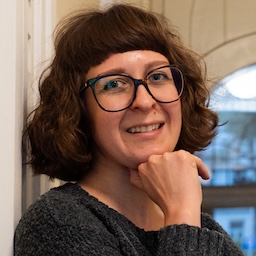“Oneg Shabbat”, the story of the Warsaw ghetto secret archive: an interview with historian Katarzyna Person
The Ringelblum Archive, also known as the Oneg Shabbat archive, is one of the most significant collections of documents about the Holocaust, created secretly within the Warsaw ghetto. Led by historian Emanuel Ringelblum, a group of scholars and community activists collected diaries, letters, drawings and essays, creating a powerful, firsthand account of life inside the ghetto. In 1942 and 1943, realizing the urgency of preserving their work, the team buried thousands of documents in metal boxes and milk cans, hoping someone would one day recover them. After the war, parts of the archive were unearthed beneath the ruins of Warsaw.
We asked the director of the Warsaw Ghetto Museum, historian Katarzyna Person to reflect on the story of this archive, a testament to resistance and the will to preserve memory in the face of genocide.

What were the key events in the 86-year-long history of the Oneg Shabbat archive?
It all starts in many ways before the war, with the changes in concept and research on Jewish history, with the work of YIVO Institute for Jewish Research, which Ringelblum himself was deeply rooted in. But the archive as such begins with notes that he started writing at the outbreak of the war, which clearly aimed to serve future historians, including most likely himself, who would write about the Holocaust and about the war period in Poland. We know that many people did the same. Yet what sets Ringelblum apart is that he realized very quickly that to gather the full story of the Warsaw ghetto, you needed a much wider group of people, with a variety of skills. That’s how the archive started around the time the ghetto was being closed off, in November 1940.
The mission of this archive was not only to document but also to create a source base about the Warsaw ghetto for future historians. What is absolutely fascinating is how wide-ranging this source base was intended to be, in terms of methodology. The team deliberately first reached out to people whose voices had been silenced, people whose stories had previously been underreported, especially since the start of the war. Ringelblum consciously reached out to women and to those who were at the very bottom of the socio-economic ladder. But also to people who were at the top but were shunned by the community as collaborators, smugglers, or members of Judenrat and the Jewish police. We can also find the voices of former politicians, refugees and children. The fact that these witnesses were not passively handing over stories but taking an active place in creating a narrative is incredibly interesting and unusual. In many cases, they were given the opportunity to tell their stories the way they wanted. The Ringelblum archive is very precise methodologically: the team used numerous questionnaires, and various, well-structured ways of collecting history. This comes across very clearly, for example, in the testimonies of women collected by Cecylia Słapakowa: she let them tell their stories as they wished. Members of the archive team also allowed people to dwell on life as it was before the war. For many, especially those who were extremely impoverished in the ghetto, this was a psychological opportunity to go back to the prewar period and portray themselves as “regular people,” as “normal” women who’d had “regular” lives before they were shattered.
During the first stage of the archive work, the goal was to gather material about all aspects of life in the ghetto – sometimes with a critical approach. Ringelblum wanted to create a picture of a community under extreme duress and to do so as fully as possible. He deliberately included some “dark” parts of this story, such as social conflict, lack of cohesion within the community, the breakdown of families, the collapse of social structures. At some point, it became clear that these documents would be passed on to future historians and that the people who were gathering them might not necessarily be those who would analyze them, because the team might not survive. It's especially heroic to consciously portray your own community in ways that aren't all necessarily positive. Some of this the team did consciously, hoping that those guilty of crimes or misdeeds would one day face justice. Ringelblum wrote about this. For example, there are stories depicting the cruelty of the Jewish police. His writing shows that he considered them as guilty. But mostly, his motivation was to document the many ways a community was then active, and to describe the people who took action.
What about the testimonies of political or ideological opponents? Did the archive incorporate the voices of Nazis or of collaborators?
This brings us to the second stage of the archive’s work, when the Oneg Shabbat group started the “Two-and-a-Half Year” project. In January 1942, they began to methodologically write down collected stories. The concept shifted into actually writing history. They created layouts, blueprints for different issues. This allows us to see which topics they wanted to cover and how comprehensive they intended it all to be. The team included stories it found uncomfortable. From his diary, we can see that Ringelblum was a highly principled man with a clear worldview. He very consciously included the testimonies of people he didn’t agree with. He conducted interviews with Jewish policemen, in which they tried to defend themselves or show their activity in a specific light. Ringelblum’s notes about them are very negative, but in the archive we get all sides of the story.
When it comes to women, Ringelblum did have a clearly traditional view of women. For example, in his first sketch of how women should be studied in the ghetto, he sees them either as homemakers or as heroes. He has a vision of women acting in an incredibly heroic way during the war, taking over family duties, taking over duties of absent men, but also keeping the family alive one way or another, and sacrificing for the children. But the study written by Cecylia Słapakowa, which I mentioned, is entirely different. She looked at women from the viewpoint of another woman and also as someone with a prewar background in social work and in hard-hitting social journalism. Her view of women in the ghetto isn’t heroic at all. She described them as they are, with all their flaws, their mistakes, and all the decisions they made for various reasons, not necessarily heroic ones. She barely used the word “heroism” in the study. Perhaps just once, when she wrote that every decision a woman takes is heroic, because survival is heroism. But Słapakowa's view of heroism differs completely from Ringelblum’s. I strongly doubt that he would, for example, consider sex work as heroism. She does. Cecylia wrote about women who resorted to sex work to support their families. She didn’t judge them in any way, describing sex work as a way of coping with reality.
Yet some voices are indeed missing from the archive: the voice of religious Jews, for example. We have, of course, the sermons of rabbi Kalonymus Kalman Shapiro. We have the writings of rabbi Szymon Huberband on the destruction of religious life. But this is still very little, especially if you think about the role of spirituality in the community. Religious voices are severely underrepresented in the archive. Maybe it's natural, as those who collected the testimonies were the people Ringelblum surrounded himself with.
The third stage of the team’s work was about informing the world, becoming an information hub for all the ghettos of Nazi-occupied Poland and beyond. Information regarding the Holocaust was circulated to underground structures both in Poland and abroad. Ringelblum had been an activist before the war. Activism was in fact more important to him than working as a historian. Perhaps he combined the two roles in some way, but I think he recognized the strength he had in activism. When information about the Holocaust starts reaching the Allies in 1942, in particular about Aktion Reinhardt, he clearly sees activism as a top priority. The archive is not just a passive repository; it is something that shaped the world. The belief they had was that the world would react, that someone would do something, and that the largest Jewish community in Europe couldn’t just disappear like that. From today's perspective, this hope they held on to — especially knowing how clearly they saw what was happening around them, how they had an excellent grasp of information — is truly extraordinary. In November 1942, they were still calling for the International Red Cross to go to Treblinka and for the international community to take a stance, and they believed this would change something.

In the Ringelblum archive, the authors often expressed an appeal: “I want the world to know,” “If people know, they will put an end to this.” Here, the expression “to know” stands simply for being informed or acknowledging, but for a call to action. We know documenting war crimes or publishing the testimonies of victims does not necessarily trigger a response from the global community. The motivation of Oneg Shabbat archivists was described as the will “to become a stone that will stop the wheel of history.” Can archives have an immediate impact?
In June 1942 Ringelblum explicitly referred to the first BBC report about Nazi atrocities against Jews in Poland, based on documents that had passed through the exiled Polish government in London, and had been collected by the Oneg Shabbat group. In his diary, he wrote, “This is the end of the Holocaust because the world knows about it. The BBC is talking about it.” Until June 1942, he had believed that whatever was happening could happen because the world didn't know. Now, they knew. So that would be the end of it, he thought. We know that's not how it went. But at that time, Ringelblum held a strong belief that this report would actually change everything.
I wonder how the Ringelblum team’s perspective changed after they realized that the world knew and yet nothing was being done. How did they view the role of the archive at that point? I think they must have realized that it wouldn't save them, nor the people around them. It could only save their memories, and that would be the role of the archive.
It's quite interesting to reflect on how much thinking about the future went into the archive. For example, whether the team wrote with an educational goal in mind, seeing the archive as something that would serve people in the future, provide lessons from the ghetto, and help create a better society. They had long discussions on how to cope with children deprived of schooling, and on how that could be addressed in a postwar world. They also thought a lot about what Polish-Jewish relations would be like after the war. That's what the writer Abraham Lewin reflected on, and many others as well: how would society cope and function? They tried to provide answers, hints, to help those who would later uncover the archive and use it to draw lessons from the war, perhaps to better understand survivors, knowing what they had gone through.
The archive has many, many functions. One of them, of course, was straightforward documentation for the needs of future tribunals to bring criminals to justice. But also, I think many of the documents serve a practical need to help build a better future society.
When did the Ringelblum team decide they should hide the archive? Was it at the start of the Warsaw ghetto uprising?
The first decision comes during the deportation action of August 1942: they gather the so-called “First part” of the archive and hide it on Nowolipki Street. The “Second part” is hidden in early February 1943. The Warsaw uprising was about to happen, but nobody knew that yet. What was more decisive was the full liquidation of the ghetto, which was approaching. That's what people knew, and that’s what they prepared for, however they could. Some of them planned for an armed struggle (a very small group). The vast majority thought about hiding and preparing hideouts. So they were focused on survival, and the archive was hidden at that point.
After the archive was uncovered after the war, it started to serve a completely different purpose. Actually, many purposes. It started to serve political and propaganda purposes. It became a very difficult link to life as it had existed in the ghetto, incredibly difficult because the complex story it told wasn’t necessarily accepted. Accepted may not be the right word. It couldn’t serve the needs of survivors, either spiritually, emotionally, or politically. How do you cope with such an incredibly difficult story? What do you accept as part of the story, your own story, and how? Do you know what to do? Basically the archive was partly silenced, because of the voices in it that were uncomfortable to listen to… We’re talking about the Poland of 1946, so this wasn’t only about “comfort”, it was about saving your own life.
We should also remember that the Ringelblum archive was misused politically in 1968 when the Communist regime’s campaign of anti-Semitism referred to parts of it. Those parts were about the Jewish police and Jewish “participation” in the deportations. The Ringelblum archive has a difficult legacy.
A large project is currently underway to publish in English several edited volumes of the archive's documents. This is the second major publishing project related to the Ringelblum archive. The first began in the late 1990s when a group of researchers collected and edited the rescued materials in Polish. Could you tell us more about the editing process?
It’s a fascinating project. It was initiated in the 1990s by the Jewish Historical Institute. As I said, only certain parts of the Ringelblum archive had been published after the war. Many were heavily censored in Poland, on two levels. One was regular Communist regime censorship, which every book underwent. The other one was self-censorship, which editors performed for many reasons. They chose to cut out certain aspects of the community’s experience during the war because of the context of Jewish life in post-war Poland. Almost nothing was published in its entirety. The Polish and Yiddish editions issued in Poland became a basis for publications abroad. English and French volumes of Ringelblum’s notes were never complete because they were based on censored Polish publications.
So in the 1990s the idea arose to publish everything, the Ringelblum archive in its entirety. And that's what happened. We also added academic apparatus to it. It was a huge undertaking with over 70 people involved in it: editors, translators, academics. The archival material was very difficult to work with. It was also often very badly preserved, its pages mixed up, and with handwritten notes made simultaneously in two or more languages (Polish, Yiddish, Hebrew, German). These sources hadn’t been accessible for many years. So simply reading it all, transcribing, translating if necessary, was huge work.
The Polish edition and the English editions came out in 2017. The fact that the preserved archive is now available in English, and that an academic edition is out too, is incredibly important. We published many sources that aren’t always easily readable for the general public, such as official documents. However, there are also texts that offer an amazing read. We decided to publish some of those documents separately, in a more accessible way. For example, diaries.
What can today's documentators across the globe learn from the Ringelblum archive and its history? What are the possible lessons for those who might despair and be frustrated that their work might be lost or never achieve its purpose or the hopes attached to it?
It's difficult to say because the Ringelblum archive was preserved purely by chance. If it had been located perhaps ten meters further away it might never have been found, and if Hersz Wasser had died during the war, it would surely never have been found. There are so many little pieces of luck on the path that led to the archive being found that you can't entirely say it was purely by chance.
But maybe the archive is not only about the documents or the lessons for the future; it's also about how it changed the lives of people who were forming it, how it affected the last years of their lives — and why would that be less important? Working in the archive, creating the archive, was maybe just as important as those pieces of paper that were found. The archive is not only about the archive. The Ringelblum archive shows us something about the people who created it. We can learn from this incredible bravery, from how they faced the complexity of one's community. That's perhaps something that was never achieved to this extent before. To have this unbelievable bravery, honesty and decency, to write about such difficult aspects of your community’s life and to preserve it for the future. Something that you're not proud of in any way whatsoever and something that may lead people to see your own community negatively after the war. The Ringelblum Archive is so powerful, important and widely read because of the complexity it conveys. And that's, I think, something that we can learn from them.
